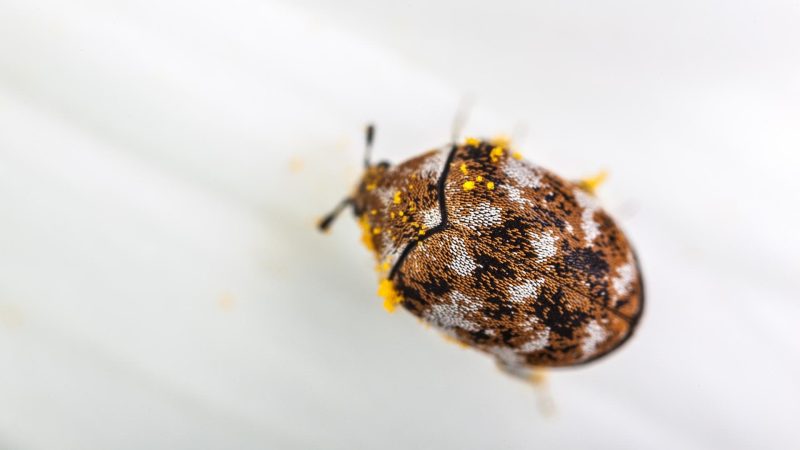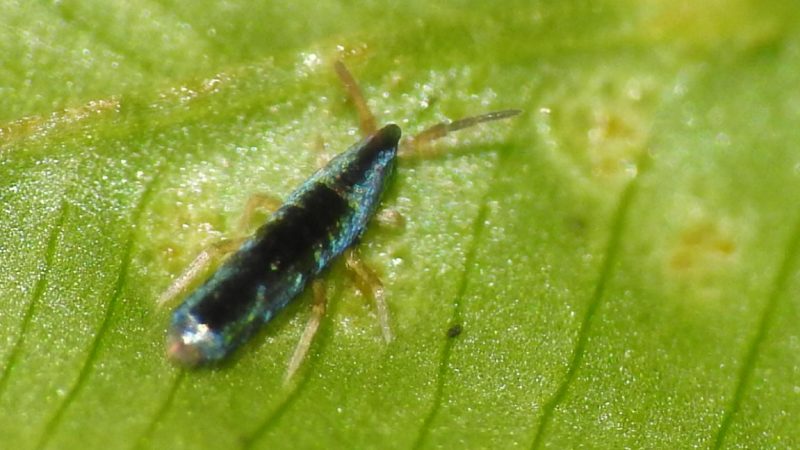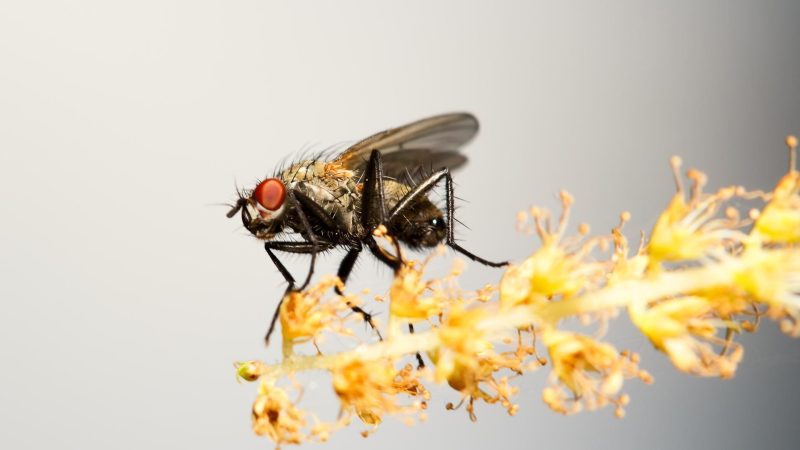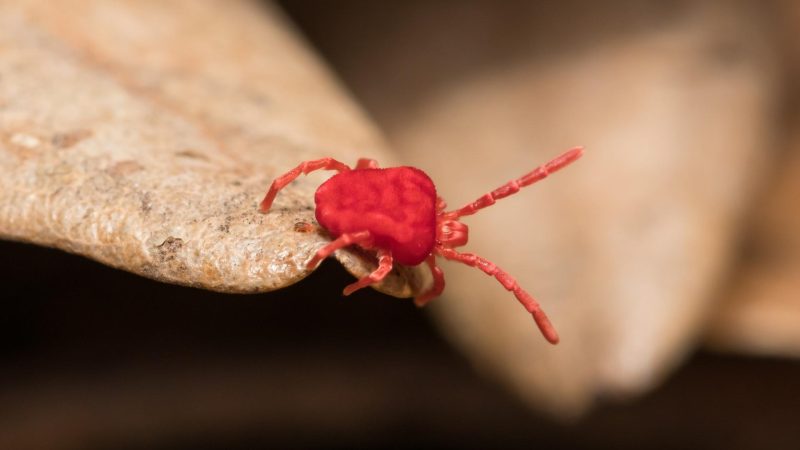If there are tiny black bugs in your window sill, chances are you will soon experience a bug infestation. But before you take action, you should know what kind of bugs you will be dealing with.
Otherwise, you might be adding more problems instead of solving them, and it will be more expensive on your part.
What are the tiny bugs on your window sill? They are usually adult carpet beetles, springtails, cluster flies, carpenter ants, and clover mites. Some of them are look-alikes, and their differences are difficult to spot by the naked eye.
Once these little black bugs in houses are in multitude, they can be nuisance pests. Some of them will hide in dark, hidden places, while others may be on your window sill.
Bugs may also damage your food, clothes, and furniture. In this article, you will know how to identify them and how to get rid of them naturally.
Top 5 Tiny Bugs on Window Sill
1. Adult Carpet Beetles

Carpet beetles belong to the family of tiny bugs called Dermestidae and have rounded bodies and short antennae.
They have the same shape as common lady beetles, but their small size can also be mistaken for bed bugs. Females lay eggs on furs, woolen fabric, carpets, and other materials that contain keratin.
The three common types of carpet beetles are varied carpet beetle, furniture carpet beetle, and black carpet beetle.
All of them are black, but varied carpet beetles have an irregular pattern of brown, dark yellow, and white scales on their wing covers, while furniture carpet beetles have some black spots on their wings.
On the other hand, black carpet beetles have shiny black bodies and brown legs. In general, carpet beetle larvae feed and damage carpets, while the adult ones feed on plants that produce pollen and nectar.
Despite adults being mostly outdoors, they enter houses and stay on the window sill or near window panes.
Why Are Adult Carpet Beetles on Window Sill?
Adult carpet beetles enter homes because they are very attracted to light. These tiny black bugs on the window sill will fly and seek animal-based material where they lay eggs but will soon go back to the windows.
They will fly back to the garden to find food, while larvae will remain indoors until they become adults.
Can Carpet Beetles Make You Sick?
Carpet beetles cannot make you sick simply because they don’t bite humans and they don’t carry diseases. Nonetheless, their larvae can cause severe damage to carpets, leather, rugs, silk, wool, pet hair, and feathers.
They may also be in pantries, feeding on heavily stored products such as grains and spices.
How Do I Get Rid of Carpet Beetles Naturally?
A few adult carpet beetles indoors are not really a problem since these tiny bugs on the window sill can easily be eliminated.
However, larvae populate quickly and dwell in dark, undisturbed areas where found is available. Using pesticides is not recommended, so here are some tips to get rid of carpet beetles naturally:
- To trap numerous little bugs on the window sill, place double-sided sticky traps on windows, such as Kensizer 20-Pack Window Fly Traps .
- To kill carpet beetle eggs and larvae, vacuum all carpets, rugs, and other fabric materials. Larvae don’t eat synthetic fibers, though.
- Wash all washable fabrics with hot water and detergent. For non-washable rugs and carpets, use a steam cleaner such as Hoover Power Scrub Deluxe Carpet Cleaner Machine .
- To help detect and monitor where they are coming from, use plain sticky traps such as Catchmaster Insect Trap & Monitors 288i .
- For closets and cabinets, hang moth cakes inside, such as Enoz Moth Cake Pack . This product not only kills clothes moths but also carpet beetle larvae.
- You can also try pheromone traps, but they only attract male adults. They may also have a very strong smell, and not all products are effective for carpet beetles.
- To prevent carpet beetles from entering your home, secure all window screens, doors, and seal all cracks and crevices.
2. Springtails

Springtails are wingless insects that have elongated scaled bodies, short antennae, and can vary between 1/16 and 1/8 inches long.
They are sometimes mistaken for fleas because of their great ability to jump several inches away. This is due to their tail-like structure (or furcula) tucked under their abdomen.
Belonging to the subclass Collembola, springtails can be found in damp areas outdoors, such as vegetable gardens, mud puddles, and swimming pools. Indoors, they appear on wet locations such as bathtubs, floor drains, and kitchen sinks. Depending on the species, they can be grey, black, brown, or white.
Generally speaking, springtails feed on algae, fungi, molds, or any kind of decaying plant material.
But when food is scarce, these jumping bugs will enter homes to find moisture and may pass through tiny gaps on walls or small cracks on windows and doors. These tiny bugs in houses can accumulate very fast.
Why Are Springtails on Window Sill?
Springtails love areas with high humidity and are also attracted to light. If your windows have signs of wearing off due to frequent heavy rains, you may see them on the window sill.
They may also appear if you have some potted indoor plants on your windows. Hundreds of them may show up unless you take action.
Can Springtails Make You Sick?
Springtails are harmless and don’t bite humans. They also don’t carry any disease and cannot make you sick, but they are still troublesome.
Aside from the damage that springtails can cause to your garden especially to germinating seedlings, huge numbers can also be nuisance pests to swimming pools.
How Do I Get Rid of Springtails Naturally?
Moisture is the main cause why springtails are abundant in your garden and inside your house. Pesticides are not effective in eradicating these pests, and therefore, are not recommended.
Instead, focus on areas where you can reduce or eliminate moisture. Below are some natural ways to get rid of springtails:
- If there are only a few springtails, vacuum them or remove them by hand.
- Remove or dispose of wet, unnecessary wood and wooden structures.
- For moldy wooden furniture, spray dishwashing soap solution. You can also use mold removal products such as Concrobium Mold Control Spray .
- Dry infested areas using an electric fan or dehumidifier.
- Remove excessive mulch around the foundation of your home.
- For vegetable gardens, reduce irrigation and provide a good drainage system.
Related: Springtail Control: How To Get Rid of Springtails?
3. Cluster Flies

Cluster flies look like common houseflies, except that they are bigger, dark gray, and have golden-yellow hairs on their thorax.
As the name suggests, this fly species appear in clusters when invading homes, especially during winter. For each growing season, there could be as many as four generations present.
Scientifically known as Pollenia rudis, cluster flies start to appear in the fall in search of warmer areas. Adults lay eggs in the soil in the summer and hatch after about 3 days.
Their larvae become parasites of earthworms in turf and fields. Outdoors, adult cluster flies feed on fruits and nectar of flowering plants.
When the winter comes, cluster flies will enter homes in huge numbers and can be very difficult to control. They will pass through all possible entry points, including wall cracks and crevices, ceilings voids, damaged window screens, and attics.
These tiny black bugs in houses are also seen flying and buzzing around on the window sill.
Why Are Cluster Flies on Window Sill?
During cold months, cluster flies on the window sill are signs of fly infestation and may look like a swarm of bees. They also rest in dark corners, under the edges of cabinets and furniture, beneath the curtains, and in upper parts of the house.
Once summer arrives, these little bugs on the window sill try to find their way out.
Can Cluster Flies Make You Sick?
Unlike houseflies, cluster flies don’t feed on garbage and human waste. Therefore, they don’t carry diseases and cannot make you sick.
No matter how many clusters of flies there are inside your house, these pesky pests will not bite you. Aside from being harmless, they also don’t cause damage to properties.
How Do I Get Rid of Cluster Flies Naturally?
A cluster fly infestation is very hard to control, and there is no perfect solution to kill all of them. Nonetheless, they cannot survive long indoors and will leave on their own once summer arrives.
And because spraying insecticides indoors can pose health risks, here are some of the natural ways to get rid of cluster flies:
- Cluster flies move very slowly, which means you can easily vacuum them.
- If they are flying all over your house, kill them using the CUNCUI Fly Swatters Heavy Duty Set . This product is lightweight and has an extendable handle.
- For heavy infestations, hang non-toxic sticky fly strips such as Dr. Killigan's The Fly Inn | Window Fly Traps .
- To prevent cluster flies from entering your house, seal all cracks and openings from the outside.
- Repair or replace damaged screens on windows and doors.
4. Carpenter Ants
Carpenter ants are mostly black, but some species are red and black or yellow and black. They have narrow waists, bent antennae, and an evenly rounded thorax.
Just like other ant species, carpenter ants live in a colony. They are composed of workers and a queen that loses its wings once there is a new nest.
Scientifically known as Camponotus, carpenter ants damage wood and wooden structures, but they don’t eat wood. Instead, they excavate it to build their nests and expand it, compromising its structural integrity.
They can establish a colony on both dry and wet food, but they prefer wood that has moisture in it.
Carpenter ants feed on fruit juices, nectar, insects (dead or alive), and sugar-rich honeydew expelled by plant-sucking insects. Indoors, they eat meat, pet food, and sweets, such as sugar, jelly, and honey.
Their nests are usually in moist, hollow spaces or even in open spaces with moist such as wooden window sill
Why Are Carpenter Ants on Window Sill?
Carpenter ants usually make nests on the wooden window sill to serve as satellites of their bigger parent nest outside of homes.
Although there could be other wooded areas inside the house, they prefer indoor nests near the windows because they can easily travel back and forth from their main to the satellite nest.
Can Carpenter Ants Make You Sick?
Carpenter ants cannot make you sick, and they don’t sting or carry diseases. However, they will bite humans in self-defense especially if you try to destroy or disturb their nest.
Carpenter ant bites are quite painful and can break the skin but are not dangerous. Unlike fire ants, this ant species is harmless to people and pets.
How Do I Get Rid of Carpenter Ants Naturally?
Spraying insecticides on worker ants is not a permanent solution because you need to destroy their nest completely and kill their queen.
Carpenter ants are most active after sunset, which is the best time to locate their nests indoors and outdoors. Here are some ways in getting rid of carpenter ants naturally:
- Attract worker ants to come out from their nest. Use non-toxic baits such as sugar, sweet foods, mealworms, or Advance Carpenter Ant Bait .
- In some cases, you may need to drill holes so you can have access to their nests.
- Once you have found their nest, slowly replace the non-toxic bait with the toxic ones such as TERRO T300B Liquid Ant Killer . Such products work slowly so that the ants can share them with the rest of the colony, including their queen.
- You can also apply Diatomaceous Earth (DE) or boric acid directly to their nest. Both of them can kill ants but have a low level of toxicity to humans.
- If possible, throw away or burn infested wood where the ants made their nest.
- As a preventive measure, store your firewood in elevated locations outdoors and several feet away from your home. Get only those that you can use for the day.
- Trim tree branches near your roof that can serve as access to your attic.
Related: How to Get Rid of Carpenter Ants Without an Exterminator
5. Clover Mites

Scientifically known as Bryobia praetiosa, clover mites are not insects but are rather arachnids.
They have eight legs and are tiny relatives of spiders and ticks. Clover mites are usually reddish-green, about 0.75 mm long, and have an elongated front pair of legs, which makes them very unique as compared to other mites.
As the name suggests, clover mites prefer feeding on clovers and lawn grasses but will also suck juices of certain ornamental shrubs and trees.
These plant feeders are usually abundant in plant beds, well-fertilized lawns, and outside walls of homes and other structures with a heavy growth of healthy grass.
Clover mites love moderate temperatures, so they are most active and lay eggs during spring and fall. On the other hand, they hate extreme temperatures, so they are relatively inactive during summer and winter.
Overwintering adult clover mites tend to become one of the most annoying nuisance pests to homeowners.
Why Are Clover Mites on Window Sill?
Clover mites don’t have wings, so they cannot fly. But once the weather becomes unfavorable for them or food is insufficient, these stubborn mites will climb the exterior walls and enter the house through cracks and crevices.
To the naked eye, clover mites look like specks or dark spots appearing on your window sill.
Can Clover Mites Make You Sick?
Clover mites cannot make you sick. Fortunately, they don’t carry diseases, and they don’t bite humans or feed on blood.
They also don’t damage plants and properties, but a clover mite infestation can be very bothersome. Crushing them on walls and other surfaces leaves a red stain, which can be mistaken for blood.
How Do I Get Rid of Clover Mites Naturally?
Clover mites don’t usually survive indoors and will leave if they cannot find sources of food. Otherwise, they will die of dehydration.
If you have indoor plants, these pesky pests will remain inside but will not reproduce. Since using pesticides is not advisable, here are some natural ways to get rid of clover mites:
- Spray soap and water directly on clover mites or carefully wipe them with a soapy rag or sponge. To avoid stains, don’t crush them.
- Vacuum all infested areas and burn the used bag or dispose of them properly.
- Outdoors, apply or spray pyrethroid insecticides such as Durvet Permethrin 10% on foundation and exterior walls where clover mites are seen inside.
- To prevent clover mites from entering your house, create a grass-free zone around your house with an area of about 18 to 24 inches wide.
- Fill your garden with flowering plants that don’t attract clover mites. Among them are chrysanthemum, marigold, rose, salvia, petunia, and zinnia.
Related: Tiny Red Bugs on Concrete | What Are Clover Mites?
Summary
Getting rid of small black bugs in houses depends on the species you have inside your home, especially on the window sill.
Tiny black bugs in houses near the window should be dealt with based on their behavior. This is why you must know how to identify them first before taking any action.
List of Sources
Gibb, T. Small Moving Specks on the Windowsill? Purdue University.
Houseman, R. M. (2011). Clover Mites. University of Missouri.
Choe, D. H. (2020). Carpet Beetles. University of California Agriculture & Natural Resources.
Perry, E. (2007). Springtails. University of California Agriculture & Natural Resources.
Jacobs, S. (2017). Cluster Flies. PennState Extension.
- How to Get Rid of Turtles | Proven Long-Term Solutions! - August 26, 2023
- How to Get Rid of Kingsnakes | Easy & Humane! - August 26, 2023
- How to Get Rid of Northern Water Snakes | Best Solutions and Preventative Measures! - August 19, 2023

